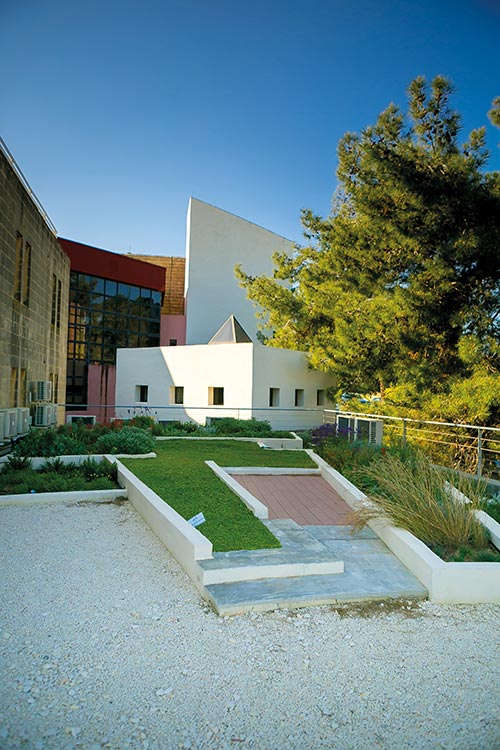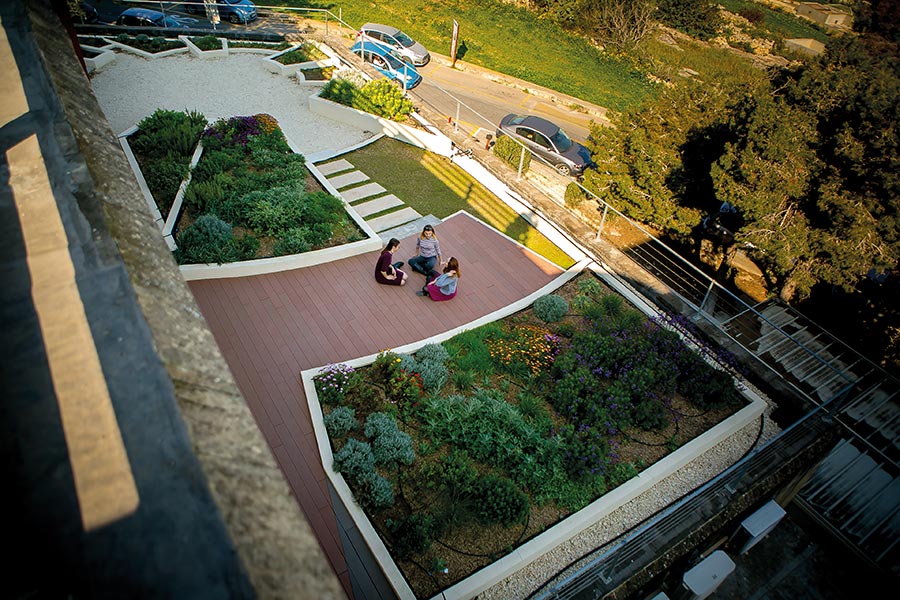Weather in Malta can be extreme. Summer is scorching. Winter brings storms. Some might blame nature and leave it at that, but there are solutions to these problems. Nigel Borg talks to Antoine Gatt about one of them.
Listen to this article as a podcast
Many tourists visit Malta for its sunny days, but as most locals know, the summer heat can be debilitating, draining everyone’s energy by early afternoon. Winter is mild and relatively pleasant; however, the occasional downpour nods towards Noah’s trials. People are quick to complain about the inconvenience this weather causes, but the consequences run much deeper, affecting our economy, our environment, but most of all, our quality of life.
High summer temperatures quickly drive up electricity bills due to air conditioner use, but it can also damage buildings. In summer, roof slab temperatures can vary from 25°C to over 60°C each day. These temperature fluctuations can be problematic, as the expansion and contraction of the roof slab and damp proofing (membrane) leads to hairline cracks. Exacerbating the situation is the ‘urban heat island phenomenon’. Towns and cities can be up to 6°C hotter than rural areas due to heat being absorbed by buildings during the day and reflected into the atmosphere at night.
And while the temperature is not much of a problem in winter, flooding can be. Even moderate downpours can slow traffic down in key areas and dole out serious damage to people’s property. Extensive hard surfaces like roads and concrete mean that rainwater is not absorbed. The lack of green spaces just makes it all worse. Road closures and even deaths are common when storms strike.

In one of the world’s smallest nations, space will always be a problem. How can we have more gardens when we barely have room for everything else on this tiny island? The answer is green roof technology. This technology is already used successfully in northern Europe; however, considering the Maltese climate, there was some question on whether it could be adapted for local use. These questions are precisely what the LifeMedGreenRoof project, managed by Antoine Gatt of the Faculty for the Built Environment, set out to answer.
The project was a baseline study on green roofs in Malta and spanned a total of four years, starting in November 2013 and finished in July 2017. Partly funded by the EU through the LIFE+ funding body, one of the main findings of the project was that green roofs act as a temperature buffer, particularly during summer months. ‘The demonstration green roof at the University of Malta was found to tame the temperature shift s, keeping it at a steady 27°C on a daily cycle’, says Gatt, ‘reducing air conditioner use and the formation of hairline cracks in the building itself.’ Overall, this would make the building more energy efficient and reduce maintenance costs on things like membrane replacement. On a national level, green roofs also help Malta reach one of the EU’s Europe 2020 Strategy targets, which include reducing energy requirements by 20%, particularly as buildings have been identified as having the greatest energy-saving potential.
The most important benefit happens over the winter months by reducing localised flooding. In the study, the green roof absorbed up to 90% of the rainfall in 2016. While it is true that the winter was relatively dry and bouts of rainfall were not too close together that year, it is still an impressive number. If implemented widely enough, they could plug the flooding problem.
The project and its trials…
There were a number of challenges which the LifeMedGreenRoof project set out to overcome. One major problem was adapting northern European technology to a Mediterranean climate and ecosystem. Apart from practical considerations, ‘a big challenge was the perception that ‘nothing grows in Malta,’ says Gatt, particularly due to our harsh summers. ‘In reality, relative to Malta’s size, we actually have more flowering plants than England!’ he added.
Also, green roofs need the right plants and growing medium. They also need other layers to help with drainage and to protect the building. A typical green roof system would consist of a total of five layers. From top to bottom these would be: the plants, the substrate or growing medium, filter fabric, the drainage module, and the root barrier. All this is laid over the damp proofing membrane and roof slab. Soil cannot be used as a growing medium for green roofs because it is too heavy. It can also contain plant seeds which would increase maintenance time.
‘Ideally, local materials would be used for the growing medium but the materials available were not appropriate,’ Gatt says. ‘We tried using crushed concrete and stone, among others, but found that the chemical composition of our rocks wasn’t good for plants to grow in.’ Other materials trialled included crushed olive stone and locally made compost. Sadly, the olive stone requires more study due to the presence of oils, and the compost was found to contain heavy metals. Substrate materials were instead imported from Italy. They included pumice, lapillus, coconut fibres, and biochar, a type of charcoal used for agricultural purposes.
Another challenge was selecting plants which can withstand the sweltering conditions on Maltese roofs. Apart from the heat, summer brings intense sunlight and high winds that can prove deadly to exposed areas. However, these conditions do not only affect roofs. Local garrigue habitats are characterised by shallow soil and very little shade, meaning that the plants found there are exposed to intense sun and wind—very much like plants on a roof would be.
The plants chosen for the trial green roof were successfully grown in this study. These included species such as Antirrhinum tortuosum (Greater Snapdragon or Papoċċi Ħomor), Hypericum aegypticum (St John’s Wort or Fexfiex tal-irdum), Cheirolophus crassifolius (Maltese Rock-Centaury or Widnet il-Baħar), and Thymbra capitata (Mediterranean Thyme or Sagħtar). Considering how some of the plants found locally are endangered and scarce, such as Anacamptis pyramidalis subsp. urvilleana (Maltese Pyramidal Orchid or Orkida Piramidali ta’ Malta), green roofs could also act as conservation beds. The diverse plant selection would also provide spaces for rare animal species. ‘One time we went up to the roof to see a swallowtail butterfly,’ Gatt says, ‘and that’s one of the rarest butterflies to see.’ The Maltese honey bee, currently thought to be facing extinction, could also find reprieve in green roofs.

Massive benefits to be reaped
The potential benefits of having green roofs are not limited to acting as a temperature buff er in summer and as flood mitigation in winter. Green roofs will add green spaces where none were previously thought possible. Given Malta’s rapid increase in construction, the aesthetic impact in many areas would be more than welcome. Implementing green roofs would soften the harshness of buildings and lend a more vibrant, varied aesthetic. Each building would have its own unique roof garden to show off.
Aside from beautification, many studies have shown that green infrastructure improves people’s well-being. Correlations were found between being around the natural environment and a healthier lifestyle, increased activity, and higher attention levels in school children. Green roofs can also serve as recreational spaces, especially in office blocks, allowing colleagues to use them as a space to socialise during breaks, much like parks abroad. They could even be used for events provided there is sufficient space. Depending on the growth medium’s depth, they can also act as noise buffers and reduce glare.
From a landlord’s perspective, all of the above increases the property’s appeal and value, while also increasing jobs in the construction industry directly related to the implementation of green roof technology. The economic benefits are huge, ripe for the picking for a startup business to turn this academic research into a new economy.
Yet another potential benefit of green roof technology is that they work very well with photovoltaic (PV) panels, whose efficiency of energy production peaks at around 25°C. Given that summer temperatures in Malta are often well above that, lowering the PV panels’ temperature would boost energy production. Luckily, green roofs help in cooling the air above them through evapotranspiration. Experiments in Hong Kong showed that combining green
The biggest challenge: Policy
Given all they have to offer, green roofs could contribute towards solving Malta’s greatest issues. It is worth keeping in mind that many of these benefits would result only if green roofs are implemented on a national scale. This brings us to the third and biggest challenge faced by the project: policy.
Following the project and its very positive results, a policy proposal has been submitted. Feedback from the government, MEPA, and the ERA have been positive.
If green roofs are to be implemented nation-wide, the right incentives and regulations are needed. The policy would need consultations with stakeholders. Financial incentives are vital to kickstart the implementation of a new technology. Incentives could take the form of something similar to what was done for PV panels, such as a tax rebate from the government based on the surface area of the green roof installed. Regulations could be put in place for certain buildings to have a green roof, such as public and commercial buildings. Something similar exists in France where commercial buildings are required to have a green roof.
A less direct form of financial incentive would be the introduction of a tax based on soil sealing, or the destruction or covering of soil by buildings. Reducing the area of exposed soil has a negative effect on flooding and ambient temperatures since it reduces soil that is available to retain rainwater. This contributes to flooding and the government’s costs in terms of flood relief. As a tax, this would be reduced based on the area of green roof installed and also on any garden present on the plot since this would help reduce flooding.
Only time will tell what will happen in terms of green roofs, but one can hope that we can look forward to a greener future; not only for our own sake but for also for our beloved islands and for the sake of those who will follow after us.




Comments are closed for this article!